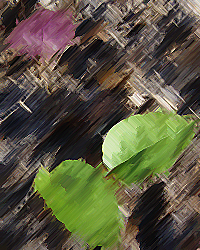Cranefly Orchid; Crippled Cranefly Orchid; Elfin Spur (Tipularia discolor)
Part of the Florida's Native and Naturalized Orchids Website
Classification:Kingdom: Plantae - Plants
Subkingdom: Tracheobionta - Vascular Plants
Superdivision: Spermatophyta - Seed plants
Division: Magnoliophyta - Flowering plants
Class: Liliopsida - Monocotyledons
Subclass: Liliidae - Lily/related subclass
Order: Orchidales - Orchid order
Family: Orchidaceae - Orchid Family
Subfamily: Epidendroideae - Epidendroids
Tribe: Calypsoeae - Calypso Tribe
Subtribe: Corallorhizinae - Corallorhiza and related
|
Distribution Map: |
Description: Synonyms: Orchis discolor Pursh, Fl. Amer. Sept. 586. 1814.; Tipularia unifolia Muhlenberg ex Britton et al., Prelim. Cat. 51. 1888, nom. illegit. Summary: Perennial woodland herbs with a chain of underground corms, the last of which will bear a single hibernal (winter) leaf which is green (often with purple spots) on the upper side and purple on the underside. Flowers borne in summer well after the leaves have faded. Flower stalks up to 18 inches tall with up to 40 small, greenish-purple flowers with a spindly, fly-like appearance. One of the few orchids (and one of the only native orchids) with distinctly asymmetrical flowers. Common Name: Cranefly Orchid; Crippled Cranefly Orchid; Elfin Spur Habitat: hardwood forests, woodlands, especially sloping banks near streams, rivers, or lakes (in Florida), or on hillsides and mountainsides (outside of Florida). Flowering season: July through August |
Images:
Description:
Fall and winter is the easiest time to look for these orchids, with their single glossy green leaves (often with purple spots on top) with purple undersides lying almost flat on the forest floor. The reason the leaves appear at this time is that the light on the forest floor is much brighter in the deciduous forests after the trees have shed their leaves. This hibernal leaf will persist throughout the winter, quite frost resistant in the more northerly states where this species is more common. In Florida, the leaves will likely never encounter snowfall or hard frost like they would in the northern portions of its range.
Once spring arrives, the leaves fade quickly and are completely gone by the time the flowering stem appears in mid-to-late summer. In Florida, it seems that roughly ten percent of the plants in a colony will bloom, making it extremely difficult to find their flowers unless you have marked the leaf locations the previous winter. Add to this the fact that the purple-green stems of flowers blend so well with the surrounding vegetation and it is very fortunate indeed when you do encounter a plant in flower.
The small flowers around 1 cm across are a transparent green with purple tinting. The lip ends toward its base in a spur-like nectary half-filled with nectar. One unusual characteristic of these flowers is a distinct asymmetry (the vast majority of orchid flowers are bilaterally symmetrical). If you take the lip as a reference, the column is tilted to one side or the other, as is the dorsal sepal. One of the lateral petals is also skewed, often overlapping the lateral sepal on that same side. This gives the flowers the look of an injured fly, hence its common name of 'Crippled Cranefly Orchid'. Research done on the pollinators (W. P. Stoutamire 1978) indicates that these flowers are pollinated by noctuid moths. Which way the column is twisted--left or right--will cause the pollinia to be deposited on either the left or right eye of the moth. I have observed a faint, sweet night fragrance in the flowers, which is consistent with this research.
Usually found on the sloping sides of river and stream banks, this species has managed to 'travel' down many riverine systems from further north, venturing as far south as central Florida -- the most southerly known colony of this species consists of a few hundred individuals along a river bank to the northeast of Ocala, Florida.
Copyright © 2009-2020 Prem Subrahmanyam, All Rights Reserved.
No Text or Images from this web site may be used, in whole or in part, without the express permission of the author.
For further information, see the Terms of Use page.









